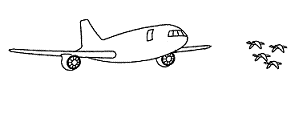Bird Strike Committee Proceedings

Bird Strike Committee-USA/Canada Joint Annual Meeting: 2nd (2000)
Date of this Version
August 2000
Document Type
Article
Abstract
An approach to the reduction of military bird strike costs is proposed. Financial return-on-investment would be maximized by focusing on the most expensive bird strikes without requiring new investment in hardware. Most of the dollar cost of military bird strikes results from strikes in the military-unique high-speed/low-altitude flight regime over remote areas. Avoiding these birds motivates a short time from detection of the bird until the pilot avoidance response because single raptors are now causing a large fraction of the losses. Ground-based sensors with communications links to pilots would be expensive because of the geographic extent of the ranges where these strikes occur. Forward-looking sensors already onboard the aircraft, however, have visibility of all the ranges, and don’t need off-board communications. Existing onboard radars in particular can detect the most threatening birds and warn the pilot in time to avoid them. The computers in these high-performance radars are programmed to remove birds (along with other "clutter") before they are displayed to the operator. New software, however, can be added to them to focus on detection, rather than rejection, of the birds that are causing most of the losses. No hardware procurement is needed. This specific design is focused on the prevention of the most costly military bird strikes. Its existence suggests the possibility that analogous designs could prevent much of the commercial, corporate, or private aircraft bird strike losses.

